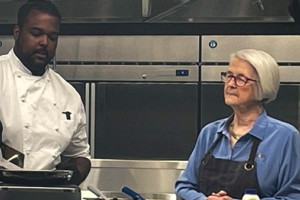Managing Food Shortages Using a Flex-Menu
on Friday, 27 May 2022. Posted in Blog & News
Chef Brenda Wattles, RDN, Contracted Menu Planner for West Ada School District, and Consultant to the Washington State Potato Commission
This is the time of year many of us are reflecting on our current year to forecast how much food and what food we will be menuing for next year. When our Food and Nutrition Services team was in this phase last year, we were filled with hope and excitement of the possibility of having a somewhat normal 2021-2022 year. So, we planned the best way we knew how. We most certainly did not forecast for food shortages. However, we did plan to serve more students.
West Ada School District is in Meridian, Idaho where there has been had nationally recognized population growth. As we planned for the 2021-2022 school year, we predicted and welcomed the new students who we hoped would be eating with us. As many of you know, that prediction can be slippery slope. Especially, when meals are free, and you don’t know what types of serving lines you will be operating based on the experiences of 2020-2021.
When this school year started and we quickly realized that our food supply was being impacted, and we scrambled. Along with food supply shortages, we were down 40% of our staff. We tried doing it with grace, but the feeling that first landed inside of me, was fear and I could see it in our team too. We feed about 25,000 meals a day throughout our 57 schools. We are in the honorable business of feeding kids so that they can grow, learn, and stay focused in school. We quickly turned that fear into that protective, “you can’t stop us”, and “we do whatever it takes to feed the kids” mode that runs in child nutrition professional’s blood and we came up with a plan.
With the food shortages, we quickly realized that not receiving truck loads and sometimes the wrong truckloads of food, was going to prohibit us from following the USDA meal pattern. We applied and were awarded the sodium, whole grain-rich, and meal pattern waivers that can be utilized due to low to no availability of certain products and food deliveries being delayed. We then came up with an electronic system to track all documentation due to food shortages and supply chain disruptions.
What we did next was not easy, but we are doing it! We created what we like to call, a Flex-Menu. In the beginning, our Director communicated with our supplier daily. Our Area Supervisors were working with their schools to inventory the food that had actually showed up at their back doors. Together, we were coming up with different, yet compliant menus for our 57 schools. That was obviously not an easy task. So, we developed a flex-menu.
First, we put categorized all of the possible food items from our bid. We made Monday’s our individually wrapped (IW) or heat and serve day. This made coming back from the weekend to prepare for a challenging week, a little easier on our staff. Tuesday’s became our ground beef day with menued items like Walking Tacos, Sloppy Joes, and Pulled Pork Tacos. Wednesdays became our pizza day. Thursdays are now our chicken days with recipes such as Chicken, Mashed Potatoes & Gravy, BBQ Chicken Sandwich, and Chicken Alfredo. Then Fridays we serve chicken and/or beef burgers. Our secondary schools also offer a second line with a grab n go sandwich or salad option. In addition, we aligned our vegetable sub-groups with a weekday: Mondays are red/orange, Tuesdays are legume, Wednesdays are dark/green (plus, another red/orange for high school), Thursdays are starchy, and Fridays are other. The flexibility that this gave our kitchens was remarkable. They were able to come up with compliant menus with what they had, not necessarily what was planned. Our moto for the year quickly became, “Plan perfectly, execute flexibly!”
I cannot say that this Flex-Menu option started out smooth. It presented challenges and we knew it would. First of all, we all know that our kitchens don’t like change. I’ve been a contractor in Child Nutrition Programs since 2008, so I know that is often the case across the nation. We’ve been doing many of the same things in our kitchens for years and our kitchen staff don’t understand the regulations like we do. Not because they don’t want to, they’ve never had to. They know how many cups of fruit and vegetables to serve, how many tacos to give per grade group, and that each student must take ½ cup of fruit or vegetable. When we first presented our Flex-Menu to our kitchen staff, they were nervous and hesitant. However, in their hearts, they wanted to feed their kids. They were not getting everything that they ordered, so they jumped on board with this new plan.
We couldn’t be doing it without our training and communication system, but most importantly we couldn’t do it without our dedicated staff. We conduct training on meal pattern compliance and offer vs serve weekly. Our director, our supervisors, and myself are verifying menus daily. In addition, we have created a daily Food Item/Recipe and Communication Log, what we like to call it FIRCL (FUR-KL). Every update, change, or question that comes through our office, gets put on FIRCL and is emailed back to our staff daily. When someone asks a question, we know that someone else likely has that same question, so those questions go on FIRCL. In addition, we add it to our Friday morning Teams call. If kitchens are short staffed and cannot attend the morning meetings, no worries, we record it.
Now, our kitchen staff are making menu changes themselves and then getting it approved by their Area Supervisor, if they didn’t get corndogs, they can serve chicken nuggets. If they didn’t get chips for their walking tacos, they can serve a Taco Rice Bowl or a Taco Burger. If they don’t have mashed potatoes, they can serve tater tots. They are getting it!
Albert Einstein once said, “In the middle of every difficulty lies opportunity.” Our greatest opportunity is that we get to feed kids. Our second greatest opportunity is that we get to impower our staff to learn and grow in their careers as child nutrition professionals. These food shortages and staff shortages have not come easy. They have been taxing on all of us, but we are doing it with grace. We are growing and we are learning from each other. Now let’s go feed kids healthy meals!
Click the link below to learn about the Washington School Nutrition Association and how Chef Brenda and others are working towards creating nutritious meals for children.







